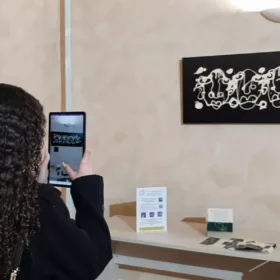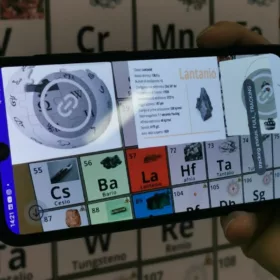Easy steps to understand Augmented Reality…
Augmented Reality means the enrichment of human sensory perception through information, generally manipulated and conveyed electronically, not perceptible with the 5 senses.
AR is based on the expansion or integration of the surrounding reality.
Augmented, means adding or making something better. In the case of Augmented Reality, also called AR, graphics, sounds and tactile feedbacks are added to our world to create an improved user experience.
This new technology allows you to superimpose multimedia information on what you are looking at on any display.
A digital level is superimposed on the physical world, integrating with it.
When Augmented Reality was born?
We started talking about AR from the 90s.
The first prototypes are born from research carried out in the military field on devices capable of displaying in the pilots’ visors virtual information relating to objectives or flight indications.
Many technologies depend, in their first years of development, on war research.
The augmented reality glasses made their appearance in a work by Ivan Sutherland from 1968, and his vision matured in the early 2000s.
How does Augmented Reality works?
Augmented reality can be observed on everyday devices such as smartphones and tablets or smart glasses. It exists when a device has a camera and an AR application software installed.
Take the device you prefer and frame any object, thanks to AR you can display any type of additional information on the display: texts, images, movies from life or animations.
What is shown on the display is partly real and partly digital. A basic principle of augmented reality is the overlay: the camera reads the object in the frame, the system recognizes it and activates a new level of communication that must be superimposed and integrated perfectly with reality.
Augmented Reality is different from Virtual Reality, which we will discuss below, it does not want to recreate an entire virtual universe, but it simply overlap some elements in the real world (that remains the main context).
The properties of AR go hand in hand with technological growth in which increasingly powerful computers are part of our lives. In this era, new generations of mobile phones and devices suitable for applications in AR are born.
Let’s not forget the news, faster network connections, like the 5G network. All these elements help to increase the potential of the device using them.
Smart Glasses and Augmented Reality
The first to tell about augmented reality glasses was the writer Frank L. Baum in The Master Key, in which the protagonist is a boy who comes into possession of technologically advanced glasses able to find out if the persons he sees are good, bad , intelligent, stupid, kind or ruthless.
This kind of glasses are the future smart glasses.
Smart glasses are wearable devices, real computers on which it is possible to start an audio and video streaming conversation, and receive information directly on the lenses of the glasses all completely hands-free.
Some AR devices have a remote control or a touchpad, some even work simply with voice commands. Their structure is light and they have a practical design.
The latest models on the market, such as Epson, Vuzix and Realwear look like simple fashionable glasses. But in reality they have an AR technology inside.
AR is rapidly growing in popularity because it brings elements of the virtual world into the real world.
Augmented reality lies between the real world and the virtual world.
Application fields of Augmented Reality
Augmented Reality in the medical field
AR allows you to record a medical procedure, carry out training for educational purposes, safely transfer clinical data, monitor the patient’s vital parameters, consult a colleague surgeon on the other side of the world in real time. B Med is the software application system suitable for medical support.
Augmented Reality in the logistic field
In some areas, Augmented reality is based on markers. A camera and some kind of visual marker are used, such as a QR / 2D code, to produce a result only when the marker is detected by a reader.
Marker-based applications use a camera on the device to distinguish a marker from any other real-world object.
Distinct but simple models are used as markers, such as a QR code, because they can be easily recognized and do not require much processing power to be read.
The position and orientation are also calculated, and a certain type of content and / or information is then superimposed on the marker. For more information, see B Take, the software application system for logistics support.
Augmented Reality based on projection
Projection-based AR works by projecting artificial light onto real-world surfaces.
Augmented reality applications based on projection allow human interaction by sending light onto a surface of the real world and thus detecting the human interaction (ie the touch) of that projected light.
The detection of the user interaction is performed by differentiating between an expected (or known) projection and the altered projection (caused by user interaction).
Another interesting application of AR based on projection uses plasma laser technology to project a three-dimensional (3D) interactive hologram into the air.
Augmented Reality based on superimposition
Superimposed augmented reality partially or completely replaces the original view of an object with a newly augmented view of that same object. In AR based on superimposition, object recognition plays a vital role because the application cannot replace the original view with an augmented view if it cannot determine what the object is.
What’s the difference between AR and VR?
Unlike virtual reality, which requires you to live in a completely virtual environment, augmented reality uses your existing natural environment and simply superimposes virtual information on it.
While both virtual and real worlds coexist harmoniously, users of augmented reality experience a new and improved natural world in which virtual information is used as a tool to provide assistance in daily activities.
The growth of AR opens up new markets and more sectors are interested in this new technology.
Recent innovations in the field of mobile technology, cloud infrastructures and wireless networks have made it possible to build AR (Augmented Reality) systems on mobile devices, introducing the research field of Mobile Augmented Reality (MAR).
Augmented Reality: the perfect choice for the mobile market!




